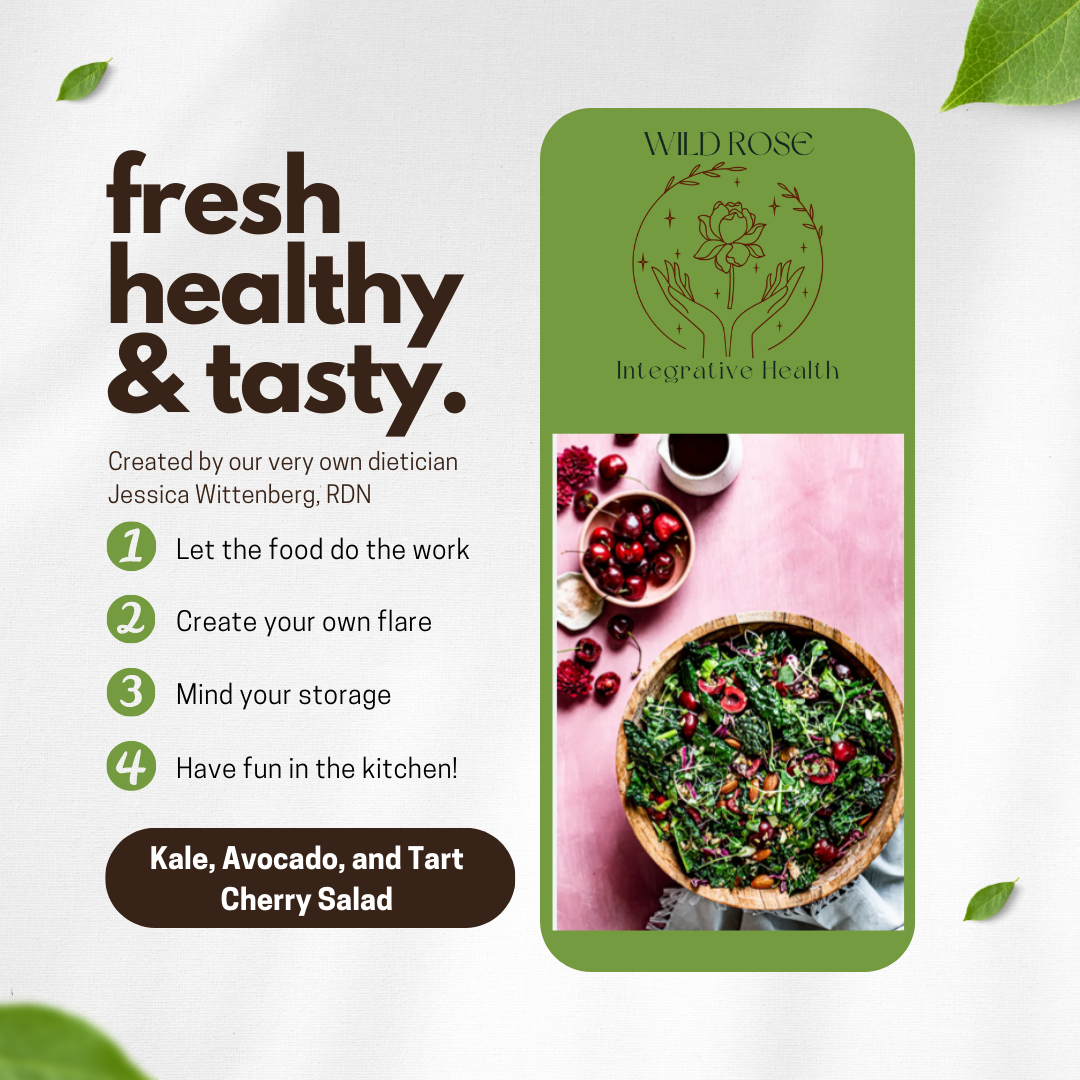|
For busy households struggling to adopt a healthy food lifestyle, this month’s featured recipe is convenient and packed full of nutrient potential. It requires simple kitchen tools, and involves just three culinary processes, cutting, grating, and juicing. It doesn’t involve any application of heat, so your home will stay cool during meal prep. It displays nutrigenomic influence and features three in-season vegetables. It can appeal to even the pickiest of young eaters, especially when ingredients are served separately.
LET THE FOOD DO THE WORK This recipe is not overly exhausting. In fact, once completing the first 2 steps, it calls for the kale to macerate, or sit, for about an hour offering you the chance to kick your feet up while science unfolds. When freshly cut cruciferous vegetables, like kale and radishes are left to sit for about an hour, an important enzyme is produced and a potent bioactive is created. Bioactives are naturally occurring compounds that influence the activation of major health promoting genes inside the body. In this instance, the cutting or chopping of cruciferous vegetables helps turn on a gene responsible for making proteins that participate in regulating inflammation. This recipe also features raw grated beet, which supplies a potent nutrient called betaine that helps the body generate new cells daily. Some individuals have trouble making new cells and don’t even know it. To be safe, an influencer ingredient added to recipes, like one from the Ameranthaceae family of plants can act as a natural detour to keep the body’s entwined cycles of cellular health running smoothly. Kale, radishes, and beets are locally available throughout Madison Valley starting the month of July. Produce gathered from backyard and community gardens or bought from weekly farmer’s market stands can save time and money by reducing food miles, contribute to your local economy, and may provide a more nutrient dense profile. CREATE YOUR OWN FLARE This recipe is quite versatile in that you can build a bowl by adding a base ingredient, like quinoa, brown rice, or whole grain fusilli or rotini pasta. Increase the amino acid profile by adding animal protein such as chicken, fish, or lean red meat and you have a delicious nutritionally balanced meal. Alternate ingredient options are provided in the recipe in the event of limited availability of ingredients. For example, the grocery store may not carry the variety of kale suggested in the recipe. Another option might include a container of fresh pre-cut baby kale of similar texture to the recommended ingredient. The original recipe, developed by Amanda Archibald, RD and founder of The Genomic Kitchen, calls for tart cherries, which can be tricky to source unless you have an Evan’s Bali, Montmorency, or Sweet Cherry Pie tree growing in your backyard. Admittedly, some of us do and this is a great opportunity to eat them fresh. For those of us who do not have this novelty, Flathead and Rainier sweet cherries are just as tasty and currently for sale at local grocery stores. MIND YOUR STORAGE Now, if you plan to make this recipe later in the week, consider how each of these perishables prefers to be stored. Personally, I’ve had to learn the hard way! Countless times, the purchase of beautiful produce ends up wilted, moldy, and smelly after only a few days in the refrigerator. Store cruciferous vegetables, carrots, beets, berries, and citrus in the high humidity drawer. This will prevent produce from wilting by preserving moisture content. Produce with thicker skin, like avocado, is best stored in the low humidity drawer, which allows ethylene gas to escape to prevent over ripening. KALE, AVOCADO, AND TART CHERRY SALAD PREP: 20 minutes (PLUS 1 HOUR for Kale to Macerate) SERVES 4 GRAB THESE: Mixing bowl Cutting board and knife Small hand grater (I use the flat kind with the white handle) Measuring spoon and cup GATHER THESE: 1 bunch kale (preferably Lacinato). Don’t forget to wash it. Juice and zest of 1 lemon (2 if the bunch of kale is big or lemon is not juicy) ¼ cup olive oil ½ teaspoon (sea) salt ¼ cup grated or peeled beet or carrot ¼ cup (or more) grated or peel daikon radish 1 ripe avocado ¼ cup tart cherries, but you can also use sweet cherries ¼ cup roasted sunflower seeds Handful of raisins Drizzle of honey as needed DO THIS:
0 Comments
|
AuthorJessica Wittenberg, RDN ArchivesCategories |
Proudly powered by Weebly

 RSS Feed
RSS Feed